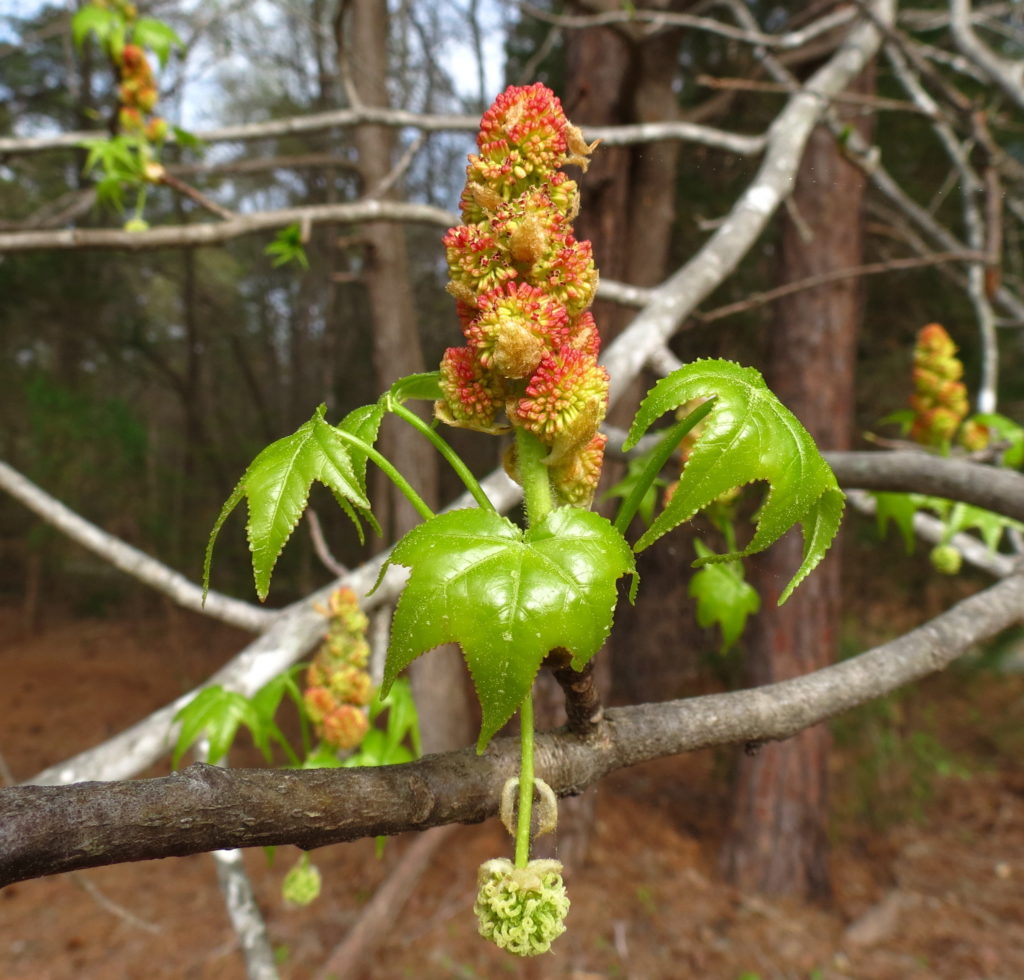
A few years back birders from all over New Jersey and some neighboring states descended upon Losen Slote Creek Park in Little Ferry to see if they could get a look at Redpolls and White-winged Crossbills that were generous enough to stop over and give us local folks a thrill. As a multitude of binoculars gazed skyward I could hear a nice young lady cry out, “There they are on the itchy balls!” I couldn’t help but laugh. I hadn’t heard the tree referred to by that name for a very, very long time . Of course, the tree that she was so happily denoting was a Liquidambar styraciflua, The Sweetgum Tree.
My first introduction to the Sweetgum goes back to my youth wandering the wild places of the Meadowlands with my friend Paul who was a West Virginia transplant . Paul would always give me some of his good old down home backwoods words of wisdom whenever he got a chance. “When your hunting squirrels in the winter always look for the tree with the little balls, they hold plenty of food when all the other trees are empty.”

As time went on I never forgot the lessons of my youth and used what I had learned from my West Virginian chum, but this time for a much more gentle purpose, to help me on my birding ventures. Find a Sweetgum in places like DeKorte Park in Lyndhurst, Mill Creek Marsh in Secaucus and Losen Slote, or wherever, and you will find birds .
The Sweetgum Tree got its name for the sweet taste and gummy feel of its sap. Native Americans and early Pioneers would chew its hard clumps of resin which could be obtained by stripping off the bark and allowing the resin to harden. Sweetgums are large trees, growing up to 100 feet tall. They have a straight trunk, up to three feet wide. Sweetgums grow in woods and along streambanks and lakes. They are easy to identify by their star-shaped leaves with five pointy lobes, and a long stalk. Fully grown leaves are about six inches long, and bright green. In the fall, leaves turn red. Sweetgum flowers are tiny, greenish, and ball-like and grow in clusters and of course there is its spiny ball-like fruit.

If there was ever a perfect wildlife tree it would be the Sweetgum. The nectar produced by the flowers attracts pollinators, hummingbirds and 33 species of native caterpillars critical to a healthy ecosystem including the Luna Moth, a declining species. And then of course there are those wonderful “little itchy balls.” The characteristic woody fruits covered with spikey prickles. Whether you know the name of the tree or not, everyone knows the tree that is guilty of those little brown prickly balls all over the ground in late fall and winter that you find yourself tripping over and the very same ones you loved to throw at friends when you were a kid.
These wonderful little wildlife magnets make the inconvenience of the little orbs on the driveway well worth having. The seeds in the gum ball structure look similar to the nyjer (thistle) seeds commonly sold for bird food and will attract the same birds as a finch feeder and more. There may be up to 50 seeds in each ball that are loved by birds such as Goldfinches ,Crossbills, Redpolls, Chickadees and Red-winged Blackbirds. Even Wild Turkey dine on the little gum ball seeds.
The next time you come across one of the seed balls on the ground pick it up and tap the ball in your hand. You will see all the tiny seeds drop out. Those seeds mean survival to many of our winter birds. Recently I read that there are Sweetgum cultivars that produce no seed balls. In my opinion this should be considered a crime against nature, like having decaffeinated coffee or non-alcoholic beer. Why bother ?
For years my neighbor had a beautiful sweetgum which hung partly over my property. When he cut it down I lost many of the great bird species that would visit my backyard. Unfortunately this is what happens to many of the backyard Sweetgums. They are cut down because homeowners get tired of raking up the many balls that get strewn all over their yards.

Just in case you are looking for something more environmentally friendly and imaginative with all those Sweetgum balls they can be used in many craft projects that are fun for the whole family http://www.sturdyforcommonthings.com/2012/12/diy-sweet-gum-ball-garland/ Plant species like the Sweetgum in the Meadowlands and in our backyards are critical to having and keeping a healthy and vibrant ecosystem in our community. It is a plant that plays an important role in providing food for our many bird species here in the Meadowlands and all of New Jersey. This winter when the birds may seem few and far between look for a Sweetgum tree and my bet is you will find the birds.

Wonderful share! I wont pass up sweet gum without looking again.
Thanks for reading Joan !